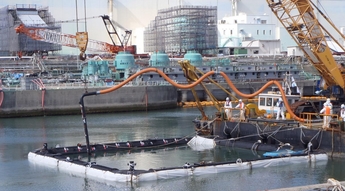TEPCO workers have finished covering the sand at the bottom of the quay in front of Fukushima Daiichi 1-4 with two layers of cement, to prevent the spread of radioactive contaminants leached in the sand.

A photograph of core samples suggests that the first layer is about 30cm thick and the second is about 20cm thick. The covering extends over the entire area of the intake channel, from a permanent piled barrier on the south to a silt fence at the north.
After work finished in early May, the focus turned to treat the seafloor. Work in front of units 5&6 started in mid-May with the installation of a silt fence; the first cover layer is expected to be completed at the end of June. The seafloor within the bounds of the north and south station breakwater (between units 1-4 and 5-6) will not be covered.
TEPCO has also published more information about its plans for monitoring of the unit 4 reactor building four times a year, 'in response to the concern that the unit 4 spent fuel pool may collapse,' it said.
First, measurements of the height of the water level on 7 February 2012 and 12 April 2012 around the edge of the 12mx10m spent fuel pool and 11m-diameter reactor well at the fifth floor have found the same distances around all sides of the pool, suggesting that the building has not tilted.
Second, TEPCO said its analysis suggests that the building will not collapse even if hit with an earthquake with a magnitude of 6 on the Richter scale (equivalent to the Tohoku-Pacific Ocean Earthquake).
Third, work to shore up the bottom of the spent fuel pool with props has increased its seismic resistance by 20%, it said.
Fourth, regular inspections will be carried out to confirm the soundness of the building. The first regular check is water level measurements. The second regular check is optical measurements of the outer walls of the building will use unspecified 'optical equipment' to measure the distance to fixed points mounted on the western and southern faces of the wall (northern and eastern faces are blocked by other buildings). The system will pick up a tilt as a deviation from perpendicularity.
The third regular check is of the condition of the concrete floor and walls of the spent fuel pool; a crack more than 1mm wide, or evidence of rebar corrosion, will require repair. The fourth regular check is the use of non-destructive techniques such as a Schmidt hammer on the spent fuel pool to measure trends in the changes of the strength of concrete.
The first report of these measures is expected to be published before the end of May.
Related ArticlesBruce 1 generates power for the first time in 15 years The Canadian plan Hiccups with Bruce A restart




